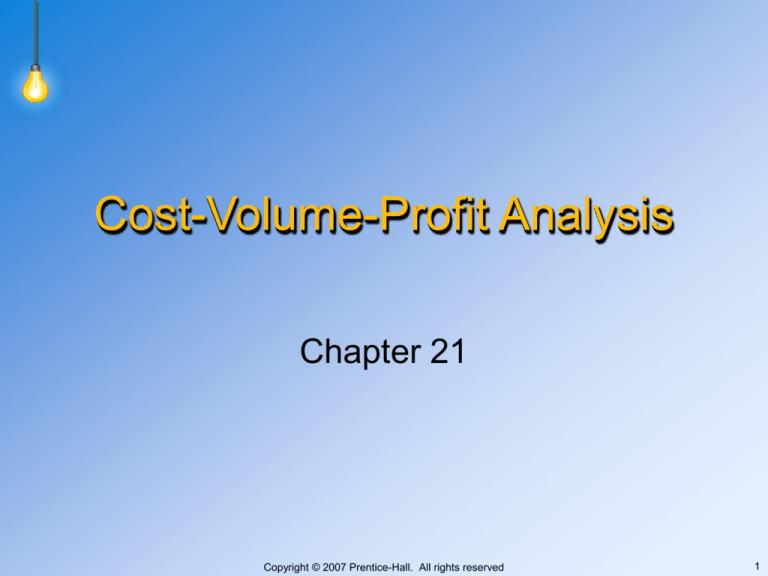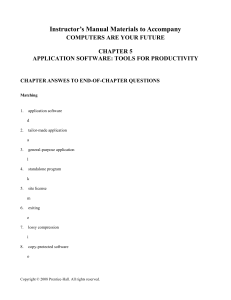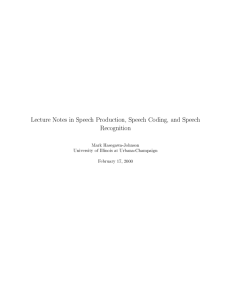
Cost-Volume-Profit Analysis
Chapter 21
Copyright © 2007 Prentice-Hall. All rights reserved
1
Objective 1
Identify how changes in volume
affect costs
Copyright © 2007 Prentice-Hall. All rights reserved
2
Cost Behavior
• How costs change in response to changes
in a cost driver
• Cost driver - any factor whose change
makes a difference in a related total cost
• Volume (units or dollars) - most prominent
cost driver in cost-volume-profit (CVP)
analysis
Copyright © 2007 Prentice-Hall. All rights reserved
3
Cost Behavior
• Variable costs - change directly in
proportion to changes in volume
• Fixed costs - remain constant (fixed) for a
given time period despite fluctuations in
volume
• Mixed costs - have both fixed and variable
components
Copyright © 2007 Prentice-Hall. All rights reserved
4
Assume we pay sales
commissions of 5% on all
sales. The cost of sales
commissions increase
proportionately with increases
in sales
Total Variable Costs
Total Sales
Commissions
$2,500
$2,000
$1,500
$1,000
$500
$0
$0
$10,000 $20,000 $30,000 $40,000
Total Sales
Copyright © 2007 Prentice-Hall. All rights reserved
5
Variable Cost Per Unit
• Variable costs per unit do not change
as activity increases
In the previous example, sales
persons get $.05 for every
dollar of sales. If a sales
person has sales of $1,000 or
$15,000, she gets $.05 for
every dollar
Copyright © 2007 Prentice-Hall. All rights reserved
6
Total Sales Salaries
Total Fixed Costs
$2,500
$2,000
$1,500
$1,000
$500
Assume we
$0pay our sales staff a salary of
$2,000 per month. If a sales person makes
$10,000
$20,000
$30,000 $40,000
sales of $500,$0
she gets
paid $2,000
salary.
If she has sales of $100,000,
she gets
paid
Total
Sales
$2,000 salary
Copyright © 2007 Prentice-Hall. All rights reserved
7
Sales Compensation
Mixed Costs
$4,500
$4,000
$3,500
$3,000
$2,500
$2,000
$1,500
$1,000
$500
A mixed cost has elements of both fixed
$0
and variable costs. Assume we pay our
$0
$10,000 $20,000 $30,000 $40,000
sales staff, $2,000 plus 5% commission on
each sales dollar
Total Sales
Copyright © 2007 Prentice-Hall. All rights reserved
8
Sales Compensation
Mixed Costs
$4,500
$4,000
$3,500
$3,000
$2,500
Variable
$2,000
$1,500
$1,000
$500
$0
Fixed
$0
$10,000 $20,000 $30,000 $40,000
Total Sales
Copyright © 2007 Prentice-Hall. All rights reserved
9
E21-14
_____
V 1. Oil filter
_____
F 2. Building rent
_____
V 3. Oil
_____
V 4. Wages of maintenance worker
_____
F 5. Television
_____
F 6. Manager’s salary
_____
F 7. Cash register
_____
F 8. Equipment
Copyright © 2007 Prentice-Hall. All rights reserved
10
E21-15 a
$80,000
$60,000
$40,000
$20,000
$0
0
5,000
10,000
Units
Copyright © 2007 Prentice-Hall. All rights reserved
11
E21-15 b
$80,000
$60,000
$40,000
$20,000
$0
0
5,000
10,000
Units
Copyright © 2007 Prentice-Hall. All rights reserved
12
E21-15 c
$80,000
$60,000
$40,000
$20,000
$0
0
5,000
10,000
Units
Copyright © 2007 Prentice-Hall. All rights reserved
13
High-Low Method
• Method to separate mixed costs into
variable and fixed components
• Select the highest level and the lowest
level of activity over a period of time
In order to do CVP analysis, we have to
classify costs as to whether they are fixed
or variable. One method of doing this is the
high-low method
Copyright © 2007 Prentice-Hall. All rights reserved
14
High-Low Method – E21-16
Step 1: Calculate variable cost/unit =
Δ total cost / Δ volume of activity
($4,000-$3,600) ÷ (1,000-600)
$400 ÷ 400 = $1
Copyright © 2007 Prentice-Hall. All rights reserved
15
High-Low Method - E21-16
Step 2: Calculate total fixed costs =
Total mixed cost – Total variable cost
$4,000 – ($1 * 1,000) = $3,000
or
$3,600 – ($1 * 600) = $3,000
Copyright © 2007 Prentice-Hall. All rights reserved
16
High-Low Method – E21-16
Step 3: Create and use an equation to
show the behavior of a mixed cost
Total mixed cost = $1x + $3,000
= ($1 * 900) + $3,000
= $3,900
Copyright © 2007 Prentice-Hall. All rights reserved
17
Relevant Range
• Band of volume: Where total fixed costs
remain constant and variable cost per unit
remains constant
• Outside the relevant range, the cost either
increases or decreases
CVP analysis is only valid within a relevant
range, which is usually the range that
could reasonably be expected for our
business
Copyright © 2007 Prentice-Hall. All rights reserved
18
Objective 2
Use CVP analysis to compute
breakeven point
Copyright © 2007 Prentice-Hall. All rights reserved
19
Assumptions
1. Expenses can be classified as either
variable or fixed
2. The only factor that affects costs is
change in volume
Copyright © 2007 Prentice-Hall. All rights reserved
20
Breakeven Point
• Sales level at which operating income is
zero
• Sales above breakeven result in a profit
• Sales below breakeven result in a loss
Copyright © 2007 Prentice-Hall. All rights reserved
21
This income statement classifies
expenses accordingContribution
to behavior margin is the excess of
sales revenue over variable costs that
contributes
to covering
fixed costs and
Contribution Margin
Income
Statement
then to providing operating income
Income Statement Approach
Sales
- Variable Costs
Contribution Margin
- Fixed Costs
Operating Income
To compute breakeven point set the
equation equal to zero
Copyright © 2007 Prentice-Hall. All rights reserved
22
Contribution Margin Approach
Breakeven units sold =
Fixed costs + Operating income
Contribution margin per unit
Copyright © 2007 Prentice-Hall. All rights reserved
23
Contribution Margin Ratio
Contribution margin ÷ Sales revenue
Breakeven sales dollars =
Fixed costs + Operating income
Contribution margin ratio
Copyright © 2007 Prentice-Hall. All rights reserved
24
E21-17 1.
Contribution margin ÷ Sales revenue
$187,500 ÷ $312,500 = 60%
Copyright © 2007 Prentice-Hall. All rights reserved
25
E21-17 2.
Aussie Travel
Contribution Margin Income Statement
Three Months Ended March 31, 2007
Sales revenue
$250,000
$360,000
Variable Costs (40%)
(100,000)
(144,000)
Contribution Margin (60%) $150,000
$216,000
Fixed Costs
(170,000)
(170,000)
Operating Income
$(20,000)
$46,000
Copyright © 2007 Prentice-Hall. All rights reserved
26
E21-17 2.
Breakeven sales dollars =
Fixed costs + Operating income
Contribution margin ratio
$170,000 + $0
.60
$283,333
Copyright © 2007 Prentice-Hall. All rights reserved
27
E21-18
1. Contribution margin = Sales–Variable costs
= $1.70 - $0.85
= $0.85
2. Breakeven units sold =
Fixed costs + Operating income
Contribution margin per unit
($85,000 + $0) / $0.85 = 100,000 units
100,000 units x $1.70 = $170,000
Copyright © 2007 Prentice-Hall. All rights reserved
28
Objective 3
Use CVP analysis for profit
planning and graph relations
Copyright © 2007 Prentice-Hall. All rights reserved
29
Use the same techniques used for
breakeven point
Plan Profits
Example: The following information is available
for Conte Company.
Sale price per unit
Variable costs per unit
Total fixed costs
Target operating income
$30
21
$180,000
$90,000
How many units must be sold to meet the
targeted operating income?
Copyright © 2007 Prentice-Hall. All rights reserved
30
Plan Profits
Sales – variable costs – fixed costs = operating income
$30x – $21x - $180,000 = $90,000
$9x = $270,000
x = 30,000 units
Copyright © 2007 Prentice-Hall. All rights reserved
31
Preparing a CVP Chart
Step 1:
– Choose a sales volume
– Plot point for total sales revenue
– Draw sales revenue line from origin
Copyright © 2007 Prentice-Hall. All rights reserved
32
Preparing a CVP Chart
$20,000
Dollars
$15,000
•
$10,000
Revenues
$5,000
$0
0
500
1,000
1,500
Volume of Units
Copyright © 2007 Prentice-Hall. All rights reserved
33
Preparing a CVP Chart
Step 2: Draw the fixed cost line
Copyright © 2007 Prentice-Hall. All rights reserved
34
Preparing a CVP Chart
$20,000
Dollars
$15,000
Revenues
Fixed costs
$10,000
$5,000
$0
0
500
1,000 1,500
Volume of Units
Copyright © 2007 Prentice-Hall. All rights reserved
35
Preparing a CVP Chart
Step 3: Draw the total cost line ( fixed
plus variable)
Copyright © 2007 Prentice-Hall. All rights reserved
36
Preparing a CVP Chart
$20,000
Dollars
$15,000
Revenues
Fixed costs
Total cost
$10,000
$5,000
$0
0
500
1,000 1,500
Volume of Units
Copyright © 2007 Prentice-Hall. All rights reserved
37
Preparing a CVP Chart
Step 4: Identify the breakeven point and
the areas of operating income and loss
Copyright © 2007 Prentice-Hall. All rights reserved
38
Preparing a CVP Chart
$20,000
Breakeven point
Dollars
$15,000
Profit
$10,000
$5,000
Loss
$0
0
500
1,000
1,500
Volume of Units
Copyright © 2007 Prentice-Hall. All rights reserved
39
E21-21
Breakeven point
$70,000
$60,000
Dollars
$50,000
$40,000
Fixed Costs
$30,000
$20,000
$10,000
$0
0
100
200
300
400
500
600
700
Volume of Units
Copyright © 2007 Prentice-Hall. All rights reserved
40
Objective 4
Use CVP methods to perform
sensitivity analysis
Copyright © 2007 Prentice-Hall. All rights reserved
41
Sensitivity Analysis
• “What if” analysis
• What if the sales price changes?
• What if costs change?
Copyright © 2007 Prentice-Hall. All rights reserved
42
E21-22
Sale price per student
Variable costs per student
Total fixed costs
$200
120
$50,000
1. Contribution margin per unit:
$200 – 120 = $80
Breakeven point:
$50,000 ÷ $80 = 625 students
Copyright © 2007 Prentice-Hall. All rights reserved
43
E21-22
Sale price per student
Variable costs per student
Total fixed costs
$180
120
$50,000
2. Contribution margin per unit:
$180 – 120 = $60
Breakeven point:
$50,000 ÷ $60 = 833 students
Copyright © 2007 Prentice-Hall. All rights reserved
44
E21-22
Sale price per student
Variable costs per student
Total fixed costs
$200
110
$50,000
2. Contribution margin per unit:
$200 – 110 = $90
Breakeven point:
$50,000 ÷ $90 = 556 students
Copyright © 2007 Prentice-Hall. All rights reserved
45
E21-22
Sale price per student
Variable costs per student
Total fixed costs
$200
120
$40,000
1. Contribution margin per unit:
$200 – 120 = $80
Breakeven point:
$40,000 ÷ $80 = 500 students
Copyright © 2007 Prentice-Hall. All rights reserved
46
Margin of Safety
• Excess of expected sales over breakeven
sales
• Drop in sales that the company can
absorb before incurring a loss
Copyright © 2007 Prentice-Hall. All rights reserved
47
E21-23
Margin of safety = Expected sales – breakeven sales
Expected sales:
Sales – variable costs – fixed costs = operating income
1x - .70x - $9,000 = $12,000
.30x = $21,000
x = $70,000
Copyright © 2007 Prentice-Hall. All rights reserved
48
E21-23
Margin of safety = Expected sales – breakeven sales
Breakeven sales:
Sales – variable costs – fixed costs = operating income
1x - .70x - $9,000 = $0
.30x = $9,000
x = $30,000
Copyright © 2007 Prentice-Hall. All rights reserved
49
E21-23
Margin of safety = Expected sales – breakeven sales
= $70,000 - $30,000
= $40,000
Copyright © 2007 Prentice-Hall. All rights reserved
50
Objective 5
Calculate the breakeven point for
multiple product lines or services
Copyright © 2007 Prentice-Hall. All rights reserved
51
Multiple Product Break-Even
Point – E21-24
Use same formulas used earlier, but compute
the weighted average contribution margin of all
products.
Sales
mix = Combination
of unit
products
Multiply each
contribution
margin per
times
Step
1:
Calculate
weighted-average
contribution
that
make
up total
the sales
mix
and sales
add
them together. Divide
margin
that
number by the total number of units in the
sales mix
Standard Chrome
Sale price per unit
$54
$78
Variable costs per unit
36
50
Contribution margin per unit
$18
$28
Sales mix in units
x2
x3
Contribution margin
$36
$84
Weighted average contribution
Margin per unit ($120 / 5)
Copyright © 2007 Prentice-Hall. All rights reserved
Total
$120
$24
52
Multiple Product Break-Even
Point – E21-24
Step 2: Calculate the breakeven point in units
Fixed costs + Operating income
Weighted average contribution margin per unit
$12,000 + $0 ÷ $24 = 500 composite units
Copyright © 2007 Prentice-Hall. All rights reserved
53
Multiple Product Break-Even
Point – E21-24
The composite unit consists of 2 standard
scooters and 3 chrome scooters. Multiply the
Step
3:
Calculate
the
breakeven
point
breakeven units x sales mix
in
units for each product line
Standard: 500 units x 2 = 1,000
Chrome: 500 units x 3 = 1,500
Copyright © 2007 Prentice-Hall. All rights reserved
54
E21-24
To earn $6,600
Fixed costs + Operating income
Weighted average contribution margin per unit
($12,000 + $6,600) ÷ $24 = 775 composite units
Standard: 775 x 2 = 1,550
Chrome: 775 x 3 = 2,325
Copyright © 2007 Prentice-Hall. All rights reserved
55
End of Chapter 21
Copyright © 2007 Prentice-Hall. All rights reserved
56









